In this month’s alert
Editorial – March 2017
Welcome to the March 2017 edition of Alcohol Alert, the Institute of Alcohol Studies newsletter, covering the latest updates on UK alcohol policy matters.
In this month’s issue, The Treasury opens consultation on having a new tax band for white cider. Other articles include: 1 in 4 adults in England drink at harmful levels; the European Commission calls for alcohol labelling; and study finds moderate drinking is linked to a lower risk of some – but not all – heart conditions.
Please click on the article titles to read them. We hope you enjoy this edition.
TOP STORY: Treasury opens consultation on new tax band for white cider
Alcohol duty rates left unchanged… for now (08 March)
The 2017 Spring Budget saw the government launch of a consultation looking into introducing a new tax band for still cider just below 7.5% ABV, to target white ciders.
The statement, published by HM Treasury, came as Chancellor Philip Hammond MP announced to the House of Commons that alcohol duties would rise in line with retail price index (RPI) inflation.

From strength to strength: The Alcohol Structures Consultation
Opened on 20 March 2017, the purpose of the Alcohol Structures Consultation is to “seek views on options to amend the structure of the alcohol duty system so that duty rates better correspond to alcoholic strength.” This involves the possibility of:
- the introduction of a new band to target cheap, high strength ‘white’ ciders, below 7.5% ABV; and
- the impacts of a new lower strength still wine band, to encourage the production and consumption of lower strength wines.
On white ciders, the government’s intention is to target those drinks, while avoiding any negative impacts that might be borne by ‘traditional cider makers’ as a result. The current excise duty system is widely regarded as inconsistent on the issue of high-strength alcoholic beverages; leading economic research group the Institute of Fiscal Studies branded the UK’s current system of alcohol excise duties “a mess”, highlighting the fact that a litre of 7.5% ABV beer is liable for 138p of tax, whereas a litre of 7.5% ABV cider (that contains exactly the same amount of ethanol) is liable for only 39p of tax.
Meanwhile, the real level of excise duty on the strongest products, spirits, has fallen by 50% since 1978/9.
HM Treasury recognises and acknowledges this in the second chapter of its report behind the consultation, which states:
Current rules allow reduced rates for still ciders below 8.5% abv. Therefore, the government could introduce a new duty band below 7.5% to split the main still cider band into two. The government is minded to introduce a new still cider and perry duty band to target high strength ‘white’ ciders, up to 7.5% abv. All products captured by this new band would pay a higher duty rate than their current rate. Those still ciders and perries in the lowest duty band would continue to pay the current duty rate.
On wines, the government has opened a discussion over the possibility of including a new duty band for still wine and made-wine between 5.5% and 8.5% ABV. As stated on the Alcohol Policy UK website, “relatively little attention to the issue of wine strength has been seen in recent duty debates, albeit that wine consumption has risen dramatically since 1980, and is the most popular UK drink category. Average wine ABVs have also been on an upward trend, partly as a result of rising temperatures and production methods in the global wine market.”
While all wines and made-wines in a band currently pay the same duty, the government’s line of thinking is that it would support any future changes to EU rules to allow the duty on wine to rise in line with alcoholic strength, as it believes such a move could help encourage the production and consumption of lower strength wines. Meanwhile:
the government would welcome evidence on the impacts a new duty band for still wine and made-wine between 5.5% and 8.5% abv could have in encouraging innovation in the lower strength wine market and encouraging the consumption of lower strength wines.
Reaction
Industry bodies who had campaigned for a cut in duty complained at across-the-board rises that would see a pint of cider and bottle of wine cost consumers (on average) 1p and 8p more respectively.
The British Beer & Pub Association was especially disappointed that beer, which cost 2p more per pint, was excluded from the Alcohol Structures Consultation.
Chairperson Brigid Simmonds urged the Treasury to look closely at how the system can be improved, particularly in the advent of the UK’s split from the European Union. She claimed that raising the lower strength threshold for beers (currently 2.8%) “would bring many more beers into the lower rate and could boost lower-strength choices for consumers.”
However, public health groups and homeless charities who had been calling for an end to white ciders welcomed the HM Treasury’s willingness to consult over an issue that has had adverse impacts on vulnerable groups in UK society.
Responding to the proposals, Katherine Brown, director of the Institute of Alcohol Studies said:
“The announced consultation on high-strength cider in today’s Budget is a promising sign that the government is serious about tackling alcohol harm amongst our most vulnerable groups. Cheap drink wrecks lives, so it is right to make these products less accessible to children, homeless and dependent drinkers.
“All the evidence shows that raising the price of alcohol is the most powerful tool governments can use to tackle harm.
“The incredibly low level of tax on high-strength ciders – the cheapest products on the market – has been identified as a problem by the Institute for Fiscal Studies, The Alcohol Health Alliance, and The All Party Parliamentary Group on Alcohol Harm.
“It is unacceptable that a three-litre bottle of white cider – equivalent to 22 vodka shots – is available for £3.50. It is also unaffordable that 167,000 years of working life are lost each year to alcohol in England.
“We hope that the government will take heed and act in order to save lives.”
The Alcohol Structures Consultation, which ends at 11.45pm on 12 June 2017, fuels the prospect that changes to the alcohol duty system will be made when Chancellor Hammond delivers his second Budget to the House of Commons later on this year.
You can click on the link to our Soundcloud page to listen to Professor Jonathan Chick and Dr Jan Gill of Edinburgh Napier University discuss cider duty in our Alcohol Alert podcast.
Drink-drive limit should be lowered, LGA says
Adapted from LocalGov (06 March)
Council chiefs have called for the drink-drive limit in England and Wales to be cut to help cut road accidents.
The Local Government Association (LGA), which represents local authorities in England and Wales, said the UK Government should lower the limit from 80mg to 50mg of alcohol per 100ml of blood.
It said lowering the limit could save up to 170 lives in the first year, rising to more than 300 lives in the sixth year, and save £300m annually by reducing the number of 999 responses and hospital admissions.
Cllr Simon Blackburn, chair of the LGA’s Safer and Stronger Communities Board, said: “England and Wales will soon have the highest drink-drive limit in Europe which is not sending the right message to motorists and safety campaigners.
“The Government should be leading by example by toughening up drink-drive laws in line with other European countries which will make roads safer and save lives. In Scotland alone, adopting a lower alcohol limit has led to a significant fall in fatal road accidents.
“Fire and rescue authorities, which run hard-hitting road safety campaigns to tackle drink driving to show the tragic consequences of road traffic collisions, want to see a lower alcohol limit introduced as it would help to reduce these fatal and traumatic accidents.”
The LGA pointed to recent provisional statistics, which showed an increase in drink-drive accidents and an increase in the number of people killed or seriously injured in drink-drive crashes.
The RAC has also called for the Government to review all the evidence, particularly from Scotland, in light of its move to lower the drink-drive limit in December 2014. It said its research showed the majority of motorists (57%) support a lower limit.
Road safety spokesman Pete Williams said: ‘There is a growing body of evidence to support a reduction in the drink-drive limit both in terms of lives saved and financial savings from reduced hospital costs.’
The RAC is one of a number of organisations that support a lower limit. Others include BRAKE, the Police Federation, Fire Brigade Union, Royal College of Emergency Medicine and the AA, all of whom feature in the ongoing campaign to lower the drink-drive limit. The latest British Social Attitudes Survey showed more than three-quarters (77%) of the public are in favour of the move.
You can watch animation ‘Save lives, safer roads, lower the drink-drive limit’ in support of the campaign on the Institute of Alcohol Studies website.
1 in 4 adults in England drink at harmful levels
Adapted from Alcohol Policy UK (07 March)
Alcohol consumption statistics published by Public Health England show that a quarter of adults drank over the current low-risk guideline of 14 units per week in 2011–14.
The statistics also highlighted stark regional variations in consumption, with 1 in 3 people in the North East drinking over the low-risk guideline. In addition, the figures show enough alcohol was sold in England for every drinker to consume 19.3 units each per week, with 65% of all alcohol being sold in the off-trade.
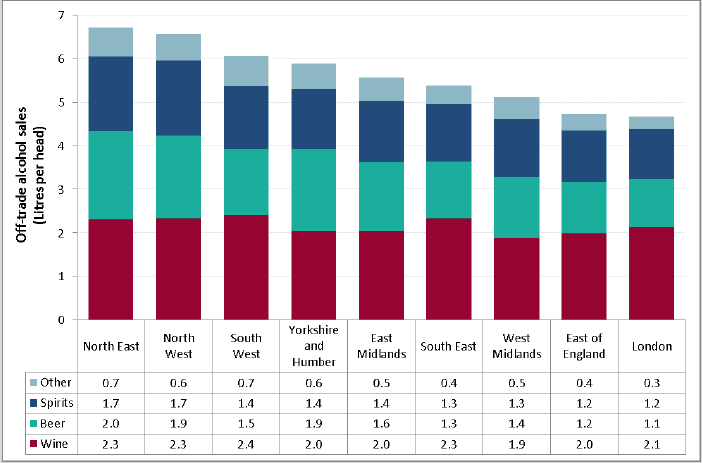 The figures supplement the annual Local Alcohol Profiles for England (LAPE), last published in February 2017. The additional datasets provide geographical data on off-sales, licensed premises and adult drinking.
The figures supplement the annual Local Alcohol Profiles for England (LAPE), last published in February 2017. The additional datasets provide geographical data on off-sales, licensed premises and adult drinking.
Key findings include:
- 25.7% of adults in England regularly drank over 14 units per week in 2011–2014.
- 15.5% of adults in England abstained from drinking alcohol in 2011–2014.
- 16.5% of adults in England were binge drinking on their heaviest day from 2011–2014.
- 10.6 units of alcohol per adult per week were sold through the off-trade in England in 2014.
- Wine sales made the largest contribution to total off-trade alcohol sales per adult throughout England (39%) in 2014.
- There were 1.3 licensed premises per km² in England in 2015/16.
- Regional and deprivation decile differences were observed within the majority of new indicators, highlighting inequality gaps and potential disproportionate levels of harm throughout the population.
Significant regional variation exists across the measures, with the North East highest for many of the indicators where 30.3% of adults regularly drink above the weekly guideline of 14 units. In contrast, London ranks lowest for many of the indicators, largely driven by 24.3% of adults abstaining – a figure 10% higher than the national average. Variation by deprivation is also significant, with the least deprived group drinking 4% more than the most deprived, as recognised in the alcohol harm paradox.
Nationally, 236 million litres of pure alcohol were sold through the off-trade in England in 2014, equating to 10.6 units per adult each week. Consumption is of course skewed, with those drinking above the guidelines consuming as much as 69% of all alcohol sold. Wine accounted for the largest volume of off-trade sales per head at 39%, followed by 27% for beer.
Binge drinking, still classified as drinking more than 6 units on an occasion for women or more than 8 units for men, also varied significantly, with a national average of 16.5% having ‘binged’ on their heaviest drinking day for the previous week. Interestingly, no correlation between binge drinking and deprivation was seen, although the value of looking at ‘snapshots’ like heaviest drinking day for assessing consumption has been questioned.
Responding to the findings, Professor Sir Ian Gilmore, chair of the Alcohol Health Alliance (UK), said:
“We are very concerned by the high numbers of people drinking at these levels. Drinking above the UK’s chief medical officers’ guideline of 14 units (for both men and women) places you at increased risk of illnesses like cancer, heart disease and liver disease.
“The fact that two-thirds of alcohol is being sold in the off-trade also means that people are able to drink at these levels very cheaply. Now is the time for the government to increase duty on the cheapest alcohol products which are disproportionately responsible for harm.
“It is also essential that the risks associated with drinking above low-risk levels are communicated to the public, so that the public are empowered to make informed choices about their consumptions. We need mandatory labelling of alcohol products, and mass media campaigns informing consumers of the health harms of drinking.”
What about national trends?
Whilst the LAPE profiles are intended to support areas identify local authority level data to inform needs assessment and planning, policy debates typically focus on national consumption. The most recent HSE data again identified a clear trend of falling consumption amongst young people, but with middle to older age adults at risk of rising consumption and harms. Recent data from the Adult Psychiatric Morbidity Survey (APMS) shows whilst hazardous drinking has fallen, harmful and dependent drinking has remained stable. Last year MESAS data has indicated an end to the downward trend in national consumption, although predictions for the future of consumption and harms is indeed a complex business.
Women & Alcohol seminar held in London
 First event of its kind reflects on the influence of alcohol marketing (10 March)
First event of its kind reflects on the influence of alcohol marketing (10 March)
The Royal College of Physicians in London was the venue for the first in a series of Women and Alcohol seminars jointly held by the Scottish Health Action on Alcohol Problems and the Institute of Alcohol Studies.
The seminar involved discussions on alcohol marketing and its reflection of and influence on women, as well as how alcohol use affects women in different social and cultural contexts.
Katherine Brown of the Institute of Alcohol Studies presented first, speaking on the effects of globalisation and alcohol marketing targeting women. Presenting examples of how alcohol marketing targeting women and men portrays women differently, she raised how this may serve to entrench stereotypes.
The second speaker, Lucy Rocca of Soberistas (pictured), discussed how binge drinking for women became normalised in the early nineties through media representations and advertising. She went on to highlight the role social media plays today in spreading alcohol messages targeting women.
Final speaker, Dr. Alison Mackiewicz, lecturer in Psychology at Aberystwyth University, spoke on the historical evolution of representations of women in alcohol advertising, noting, “Women are portrayed as being doubly deviant, for being drunk and in a dress.”
The seminar series continues on Friday 7 April in Edinburgh at the Royal College of Physicians, chaired by Professor Dorothy Newbury Birch. These events will provide an opportunity for policy makers, academics, activists, and media representatives to critically discuss topics related to women and alcohol use, to stimulate thinking, challenge attitudes and perceptions, and to think about future research and policy priorities.
You can follow the next event live on Twitter using the hashtag #WomenAndAlcohol.
For anyone interested in attending future events in this series, please email Victoria Troy at V.Troy@rcpe.ac.uk.
European Commission calls for alcohol labelling
Report gives industry one year to find solution (13 March)
The alcohol industry has been challenged to present a self-regulatory proposal for all alcoholic beverages to include ingredient and nutrition information on their labels “within a year”.
This is the conclusion of a long awaited European Commission (EC) report to the European Parliament and the Council regarding the mandatory labelling of the list of ingredients and the nutrition declaration of alcoholic beverages.
The report acknowledged mounting pressure from the European Parliament, the World Health Organisation, consumer and public health organisations for the adoption of new labelling rules for alcoholic beverages (especially concerning energy value), as well as the softening of the industry’s position from opposing mandatory labelling to largely accepting “the right of consumers to know what they are drinking”. With the nutrition declaration having become mandatory for the vast majority of pre-packed food as of 13 December 2016, the Commission could see no objective grounds that would justify the absence of information on ingredients and nutrition information on alcoholic beverages too.
On the day of the report’s publication, European Commissioner for Health and Food Safety Vytenis Andriukaitis expressed his support to this effect, stating on social media: “I see no reason #alcoholic beverages to be exempted from #labelling. Consumer needs to be informed.”
However, the result was seen as a partial success from leading alcohol policy NGO Eurocare, as the EC’s solution to implement mandatory labelling involves permitting current voluntary initiatives “to develop further”. Having noted that “the rising number of alcoholic beverages present on the EU market already bear the full nutrition declaration”, the Commission’s report invites the industry to “respond to consumers’ expectations and present within a year of adoption of this report a self-regulatory proposal that would cover the entire sector of alcoholic beverages.”
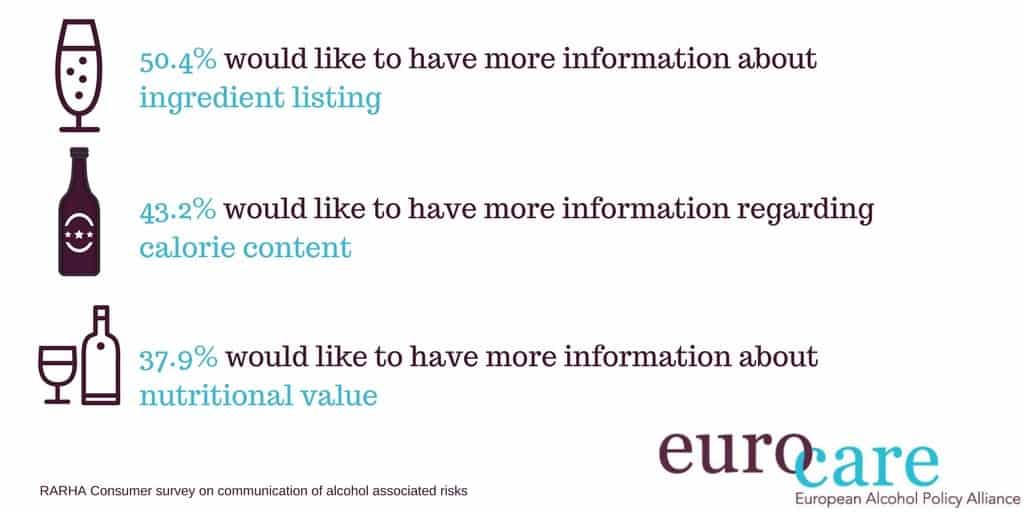 In her response to the report, Eurocare secretary general Mariann Skar said:
In her response to the report, Eurocare secretary general Mariann Skar said:
“We welcome the report as it clearly recognises the need for better alcohol labelling and widespread support for it. Disappointingly, the conclusions do not seem to be in line as it asks for self-regulatory proposals from the industry.
“Self-regulation is not a suitable regulatory mechanism. Member States in the European Council should follow up and empower the European Commission to take regulatory actions.”
In 2015, Eurocare conducted a survey which suggested that among consumers, labelling is the best way to inform people at the point of sale and consumption about the nutritional value and ingredients in alcoholic beverages.
50.4% of respondents indicated they would like to have more information about ingredient listing, 43.2% regarding calorie content and 37.9% nutritional value (illustrated); only a quarter (24.7%) of respondents sought information online regarding ingredients or additives in their alcoholic beverages. Overall, labelling information currently provided to the consumers is not sufficient.
Listing ingredients contained in a beverage alerts the consumers to the presence of any potentially harmful or problematic substances. Furthermore, providing nutritional information such as energy content allows consumers to monitor their diets better, and makes it easier to keep a healthy lifestyle. Eurocare warns that any voluntary initiatives for labelling must regarded as an opportunity for impact over time, rather than setting the expectation that they will affect immediate behavioural change, and so have committed to “closely monitoring” the industry’s progress.
Should the industry fail to meet its own objectives, the EC suggests alternative ways of implementing labelling for alcoholic beverages. As the report states: “Should the Commission consider the self-regulatory approach proposed by the industry as unsatisfactory, it would then launch an impact assessment to review further available options… (considering) regulatory as well as non-regulatory options, in particular, regarding, the provision of information on the energy value of alcoholic beverages.”
Following C&C’s lead
This EC report came in the same week C&C Group decided to display the UK Chief Medical Officers’ revised alcohol-intake guidelines on its own packaging. The guidelines will appear on 24 packs of 44cl, 50cl and 56.8cl cans of Tennent’s Lager. The updated cans will be available across Scotland.
The company said its move to include the guidelines on Tennent’s “was the logical next step” following its decision to display calorie content on its products last year.
“Consumers are increasingly more interested in their food and drink intake,” Tennent’s sales director Alan Hay said. “We are a business committed to responsibility around our brands and believe it’s important to communicate this information so our drinkers can make informed decisions about their alcohol consumption.”
Alcohol IBA e-learning scheme updated
Initiative ensures workers effectively engage with non-dependent alcohol misuse cases (17 March)
Health Education England e-Learning for Healthcare (HEE e-LfH) has worked with Public Health England (PHE) to update the Alcohol Identification and Brief Advice (Alcohol IBA) e-learning programme in line with The UK Chief Medical Officers’ 2016 guidance on low risk drinking, which helps professionals deliver simple advice to individuals whose drinking might impact their health.
The Alcohol IBA courses are available for delivery in four settings:
- Primary Care
- Community Pharmacy
- Hospitals
- Dental Teams.
The e-learning resources teach learners how to use World Health Organisation validated tools to identify patients’ levels of health risk from alcohol and how to intervene appropriately with those who could benefit from reducing their alcohol consumption.
Use of IBA is recognised as a contributor to Making Every Contact Count (MECC) and is a feature in the NHS Health Check, CQUIN programmes and efficiency savings programmes.
The overall goal of the Alcohol IBA e-learning programme is to enable the learner to effectively engage with non-dependent alcohol misusing patients, who may not realise they may be taking risks with their health.
Each of the courses aimed at primary care, community pharmacy and hospital settings is split into four e-learning sessions:
- Alcohol Facts
- Introducing IBA and Identifying Risky Behaviour
- Practising IBA and delivering brief advice
- Assessment
The course aimed at dental teams consists of four sessions:
- Facts about Alcohol
- Identification and Brief Alcohol Advice (IBA) for Dental Teams
- Practising AUDIT-C
- Assessment
The Alcohol IBA e-learning resources are available for free to all NHS staff as well as being available via OpenAthens and via PHE’s Alcohol Learning Resources website.
Moderate drinking linked to lower risk of some – but not all – heart conditions
Researchers call for “a more nuanced approach” to role of alcohol in heart health (22 March)
Moderate drinking is associated with a lower risk of several, but not all, cardiovascular diseases, according to a large study of UK adults published in the British Medical Journal (BMJ).
The finding that moderate drinking is not universally associated with a lower risk of all cardiovascular conditions suggests a more nuanced approach to the role of alcohol in prevention of cardiovascular disease is necessary, say the researchers.
Research on the health benefits of alcohol on the heart is disputed. Some research suggesting that moderate drinking may still be associated with a lower risk of developing cardiovascular disease compared with abstinence or heavy drinking.
However, other researchers have been quick to point out that those perceived benefits are outweighed by other risk factors, and previous studies have grouped non-drinkers with former drinkers, who may have stopped drinking due to poor health.
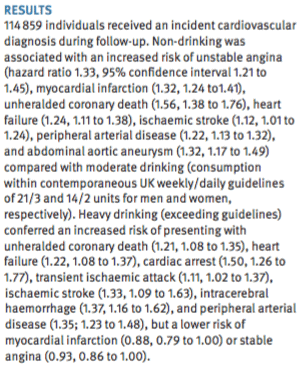 Methods
Methods
According to the BMJ, researchers at the University of Cambridge and University College London set out to investigate the association between alcohol consumption and 12 cardiovascular diseases by analysing electronic health records for 1.93 million healthy UK adults (51% women) who were at least 30 years of age between 1997 and 2010, as part of the CALIBER (ClinicAl research using LInked Bespoke studies and Electronic health Records) data resource.
All participants were free from cardiovascular disease at the start of the study, and non-drinkers were separated from former drinkers. Other participants were classified as occasional drinkers; moderate drinkers (those who drank within the recommended guidelines of the time – 21 units a week for men, 14 for women); heavy drinkers.
Results
After accounting for several factors, moderate drinking was associated with a lower risk of first presenting to a doctor with seven of the 12 cardiovascular conditions, including angina, heart failure and ischaemic stroke, compared with abstaining from alcohol (illustrated).
Heavy drinking (exceeding recommended limits set by the old guidelines) conferred an increased risk of first presenting with a range of such diseases, including heart failure, cardiac arrest and ischaemic stroke compared with moderate drinking, but carried a lower risk of heart attack and angina.
Limitations
The research team admitted that the study ran the risk of misclassification bias both because participants self-reported alcohol intake and there was a lack of standardisation in the questions set on drinking habits.
It is also important to note that the association established in this observational study is not causal and no firm conclusions can be drawn about cause and effect, that there are safer and more effective ways to lower cardiovascular risk, such as increasing physical activity and stopping smoking, and that in the case of non-drinkers, socioeconomic status played a part – they were more likely to belong to the most deprived quintile.
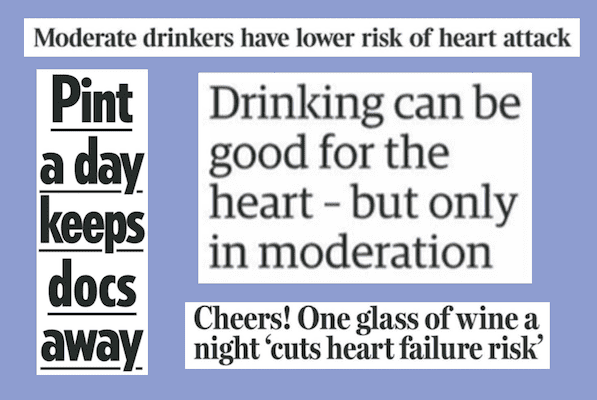
What the study didn’t show
Several national press outlets were quick to claim that drinking alcohol in moderation either “slashes” or “can lower” the risk of a heart attack (the Daily Mail and the Times respectively). However, where the Times did mention it to be the case for some but not all heart conditions, the Daily Mail article failed to do so. Both the Daily Mail and Guardian articles (“Drinking can be good for the heart – but only in moderation”), included warnings about how the perceived protective effects for heart were outweighed by increased risks of cancer and liver disease. However, the Sun’s headline “Pint a day keeps docs away” emphasised these percieved heart benefits over and above that of other health risks and alcohol dependence, in an oversimplification of the study’s findings.
The researchers concluded that from a public health perspective, the finding that moderate drinking is not universally associated with a lower risk of all cardiovascular conditions supports the chief medical officers’ (CMO) decision not to incorporate the apparent protective effects of drinking for cardiovascular disease in the current guidelines.
Commenting on the study, Professor Sir Ian Gilmore, Alcohol Health Alliance chair, said:
“As the authors of the study say, it is not possible to draw firm conclusions from the study about cause and effect between moderate alcohol consumption and heart health.
“What is clear, however, is the wide-ranging evidence base considered by the UK’s Chief Medical Officers when revising the alcohol guidelines last year.
“After reviewing the evidence, the Chief Medical Officers were clear that the benefits of drinking alcohol have been overstated in the past, with any protective effect on heart health applying to a much smaller group than previously thought: women over 55 who drink at very low levels (around 1 unit of alcohol a day). As the Chief Medical Officers have made clear, there is no reason anyone should be advised to start drinking alcohol on health grounds.
“Alcohol is linked with over 60 illnesses, including heart disease and stroke. The Chief Medical Officers advise that, to keep risks from drinking alcohol at a low level, you are safest not to regularly drink more than 14 units a week, spread across at least 3 days.”
Bereaved through Alcohol and Drugs website launched
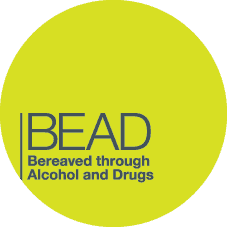 Lottery-funded project to offer support to grievers (23 March)
Lottery-funded project to offer support to grievers (23 March)
A website has been set up by Cruse Bereavement Care, the UK’s leading bereavement charity, and Adfam, the national voice for families affected by drugs and alcohol to offer support to those who have lost their loved ones as a result of drug and alcohol use.
The new Bereaved through Alcohol and Drugs (BEAD) website provides a wealth of information and resources to those unsure where to turn or what to do in such a difficult situation.
The website’s features include:
- Outlining where and how to access appropriate support
- Helping people through the grieving process by looking at the emotions one might be experiencing and how to overcome them
- Providing practical help with the things one will have to deal with a result of their loss
- Displaying stories and personal experiences
Linking to useful resources and relevant organisations.
The site was designed and developed in close partnership with a peer support volunteer who understood the needs of people accessing this service.
It is hoped that the website will augment the work they do in improving the emotional wellbeing of individuals bereaved through alcohol, ultimately becoming a vital tool for those in need of information and guidance on how to overcome their difficult situation.
ALCOHOL SNAPSHOT: Modest progress on alcohol-related health inequalities in Scotland
This month saw the latest annual update of the Scottish Government’s monitoring indicators of health inequalities in the country. These are produced for a Ministerial Task Force led by the Minister for Public Health in order to measure progress in tackling health inequalities.
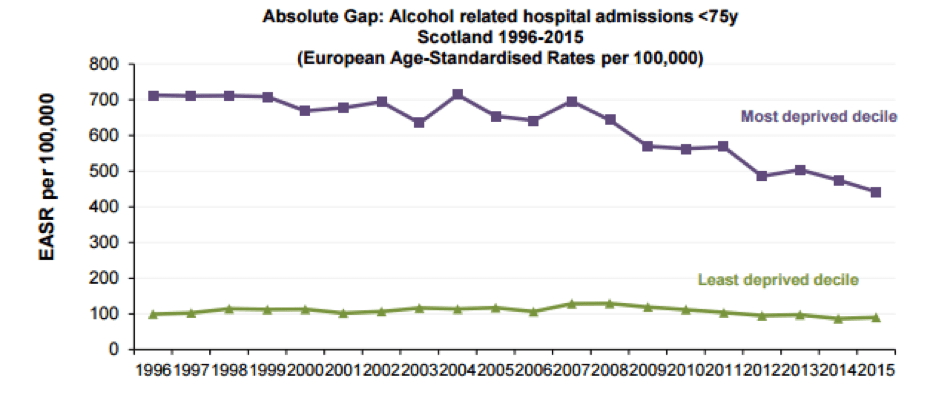
The chart above shows some positive trends in the rate of alcohol-related hospital admissions, which fell dramatically amongst the most deprived groups between 2007 and 2015, to bring the gap between rich and poor to its lowest recorded level. However, admission rates remain five times higher in the bottom than the top decile.
It is also important to put this indicator in context. Though inequality in alcohol-related mortality has declined since 2006, it rose in both 2014 and 2015, as part of a worrying increase in the aggregate mortality rate across the whole country. Moreover, inequality in alcohol-related deaths and admissions remains higher than inequality in both cancer and coronary heart disease.
Podcast
Our monthly podcast features interviews with experts from across the sector.
Gambling industry harms and parallels with the alcohol world
Will Prochaska –
Coalition to End Gambling Ads
